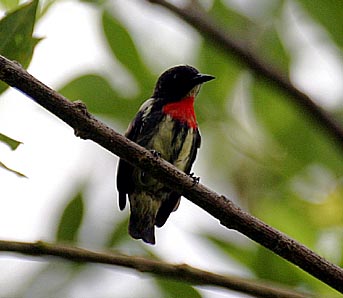(added photo) |
(added Habitat and Behaviour and References) |
||
| Line 46: | Line 46: | ||
==Habitat== | ==Habitat== | ||
| + | Montane, lowland primary and tall secondary forest, forest edge, plantations, cultivation, gardens and secondary scrub; Up to 1200 m. | ||
==Behaviour== | ==Behaviour== | ||
| + | ====Diet==== | ||
| + | Fruits, nectar and pollen of mistletoes, wild cherries and Lantana camara, small spiders and insects. Forages mainly in the upper canopy. [[Dictionary G-L#G|Gleans]] bare outer twigs. Forages alone and in pairs. | ||
| + | ====Breeding==== | ||
| + | Nest is pear-shaped, with or without a covered entrance on the side towards the top. woven out of down and fine grasses, adorned with twigs, spider silk and leaf debris. It is suspended 1.5–2 m above ground from an outer branch. 3 white eggs. | ||
| + | ====Vocalisation==== | ||
| + | Repetitive, weak and upslurred “seeei”, short, reiterated “tjjt”, short, dry, subdued “trri-tri”, and a high “tsip”; flight call is an abrupt “chip, chip, chip…” | ||
| + | ==References== | ||
| + | #{{Ref-Clements6thAug15}}#Avibase | ||
| + | #Handbook of the Birds of the World Alive (retrieved November 2015) | ||
| + | {{ref}} | ||
==External Links== | ==External Links== | ||
{{GSearch|Dicaeum+celebicum}} | {{GSearch|Dicaeum+celebicum}} | ||
[[Category:Birds]] [[Category:Dicaeum]] | [[Category:Birds]] [[Category:Dicaeum]] | ||
Revision as of 12:00, 23 November 2015
| This article is incomplete. This article is missing one or more sections. You can help the BirdForum Opus by expanding it. |
- Dicaeum celebicum
Identification
9 cm, 3.5 inches
Male
- Crown and upperparts black with purple iridescence
- Blackish face
- White throat
- Bright red patch on lower throat and breast
- Belly yellowish-white with black central line
- Black-green flanks
- Off white undertail coverts
- Dark iris
- Dark brown beak
- Black legs
Female
- Grey-brown upperparts
- Whitish-grey on throat and breast
- Grey green flanks
- Centre of belly and vent dull yellowish-white
Juvenile
- Similar to female but darker underparts
- Greener on upper breast
- Darker, greyer throat
- Lighter beak
Distribution
Sulawesi, some adjacent islands, Banggai and Sulu islands and Talaud islands, Indonesia.
Taxonomy
Subspecies
There are 4 subspecies which make up the polytypic celebicum group:[1]
- D. c. celebicum:
- Manadotua, Bangka, Sulawesi, Lembeh, Togian, Muna and Butung Islands
- D. c. talautense:Male is paler, less shiny and more blue upperparts, evenly grey-black belly and flanks, female has darker underparts
- Talaud Island, north Moluccas
- D. c. sanghirense: Male has dark blue iridescence above, greyer-white belly, purer dark grey (less geen) flanks
- Sangihe and Siau islands, off northern Sulawesi
- D. c. sulaense: Male is lighter and more purplish-blue above than D. c. kuehni, dark grey-green flanks, greyish central stripe on belly
- Banggai and Sula Islands. (Taliabu, Mangole and Sanana)
And the monotypic D. c. kuehni: Male with more bluish-purple upperparts, lighter greyish-white belly and paler, greyer flanks
- Tukangbesi Archipelago (off Sulawesi)
Habitat
Montane, lowland primary and tall secondary forest, forest edge, plantations, cultivation, gardens and secondary scrub; Up to 1200 m.
Behaviour
Diet
Fruits, nectar and pollen of mistletoes, wild cherries and Lantana camara, small spiders and insects. Forages mainly in the upper canopy. Gleans bare outer twigs. Forages alone and in pairs.
Breeding
Nest is pear-shaped, with or without a covered entrance on the side towards the top. woven out of down and fine grasses, adorned with twigs, spider silk and leaf debris. It is suspended 1.5–2 m above ground from an outer branch. 3 white eggs.
Vocalisation
Repetitive, weak and upslurred “seeei”, short, reiterated “tjjt”, short, dry, subdued “trri-tri”, and a high “tsip”; flight call is an abrupt “chip, chip, chip…”
References
- Clements, J. F., T. S. Schulenberg, M. J. Iliff, D. Roberson, T. A. Fredericks, B. L. Sullivan, and C. L. Wood. 2015. The eBird/Clements checklist of birds of the world: v2015, with updates to August 2015. Downloaded from http://www.birds.cornell.edu/clementschecklist/download/
- Avibase
- Handbook of the Birds of the World Alive (retrieved November 2015)
Recommended Citation
- BirdForum Opus contributors. (2024) Grey-sided Flowerpecker. In: BirdForum, the forum for wild birds and birding. Retrieved 25 April 2024 from https://www.birdforum.net/opus/Grey-sided_Flowerpecker





